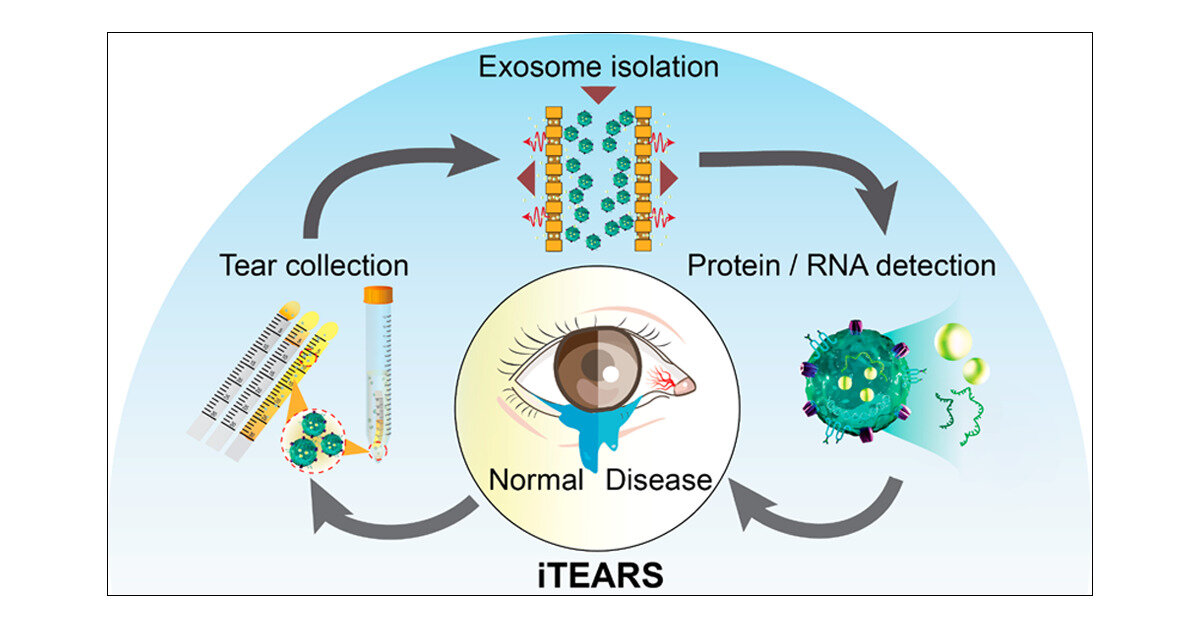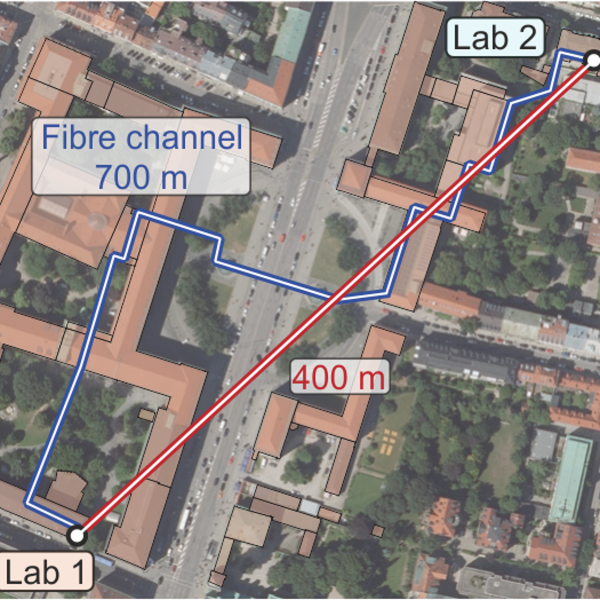
via ACS
Going to the doctor might make you want to cry, and according to a new study, doctors could someday put those tears to good use.
In ACS Nano, researchers report a nanomembrane system that harvests and purifies tiny blobs called exosomes from tears, allowing researchers to quickly analyze them for disease biomarkers. Dubbed iTEARS, the platform could enable more efficient and less invasive molecular diagnoses for many diseases and conditions, without relying solely on symptoms.
Diagnosing diseases often hinges on assessing a patient’s symptoms, which can be unobservable at early stages, or unreliably reported. Identifying molecular clues in samples from patients, such as specific proteins or genes from vesicular structures called exosomes, could improve the accuracy of diagnoses. However, current methods for isolating exosomes from these samples require long, complicated processing steps or large sample volumes. Tears are well-suited for sample collection because the fluid can be collected quickly and non-invasively, though only tiny amounts can be harvested at a time. So, Luke Lee, Fei Liu and colleagues wondered if a nanomembrane system, which they originally developed for isolating exosomes from urine and plasma, could allow them to quickly obtain these vesicles from tears and then analyze them for disease biomarkers.
The team modified their original system to handle the low volume of tears. The new system, called “Incorporated Tear Exosomes Analysis via Rapid-isolation System” (iTEARS), separated out exosomes in just 5 minutes by filtering tear solutions over nanoporous membranes with an oscillating pressure flow to reduce clogging. Proteins from the exosomes could be tagged with fluorescent probes while they were still on the device and then transferred to other instruments for further analysis. Nucleic acids were also extracted from the exosomes and analyzed. The researchers successfully distinguished between healthy controls and patients with various types of dry eye disease based on a proteomic assessment of extracted proteins. Similarly, iTEARS enabled researchers to observe differences in microRNAs between patients with diabetic retinopathy and those that didn’t have the eye condition, suggesting that the system could help track disease progression. The team says that this work could lead to a more sensitive, faster and less invasive molecular diagnosis of various diseases — using only tears.
Original Article: ‘iTEARS’ could help diagnose diseases by isolating biomarkers in tears
More from: Wenzhou Medical University | American Chemical Society
The Latest Updates from Bing News & Google News
Go deeper with Bing News on:
Biomarkers in tears
- Study reports on inflammatory, metabolic biomarkers and accelerated aging in cardiac catheterization patients
A new research paper titled "Associations among NMR-measured inflammatory and metabolic biomarkers and accelerated aging in cardiac catheterization patients" has been published in Aging.
- Researchers identify novel biomarkers in renal cell carcinomas
A new study led by University of Michigan Health Rogel Cancer Center researchers identifies novel biomarkers in renal cell carcinomas.
- Unveiling Biomarkers and Mechanisms in the Tumor-Immune Nexus
The interplay between cancer cells and the immune system is a critical area of research, with recent advancements highlighting the potential of immunotherapy in offering durable responses across ...
- Association of inflammatory and metabolic biomarkers and accelerated aging in cardiac catheterization patients
A new research paper was published in Aging, entitled, “Associations among NMR-measured inflammatory and metabolic biomarkers and accelerated aging in cardiac catheterization patients.” ...
- HE4 as a Biomarker for Ovarian and Endometrial Cancer Management
Researchers have been vigorously working on the identification of a more reliable biomarker to assist in early detection, as well as treatment- and general disease-monitoring. HE4 is among the ...
Go deeper with Google Headlines on:
Biomarkers in tears
[google_news title=”” keyword=”biomarkers in tears” num_posts=”5″ blurb_length=”0″ show_thumb=”left”]
Go deeper with Bing News on:
Molecular diagnosis
- Global Veterinary Molecular Diagnostics Industry
Global Veterinary Molecular Diagnostics Industry is estimated at US$ 194.47 million in 2023 and US$ 377.22 million by 2033, at a CAGR of 6.84% ...
- Northwell opens $3.2M Molecular Diagnostics Laboratory
The Northwell Health Cancer Institute and its Center for Genomic Medicine announced the opening of Long Island’s first clinical Molecular Diagnostics Laboratory (MDL), a $3.2 mi ...
- Cancer Diagnostics Market Size to Reach USD 204.8 Billion By 2032, at 6.6% CAGR: Dimension Market Research
The global cancer diagnostics market is engaged in diverse activities, products, and services for detecting, diagnosing, and monitoring cancer, utilizing technologies like molecular diagnostics, ...
- Molecular Diagnostics Collaboration and Licensing Deals Analysis Report 2024 with Directory of 740 Agreements Signed Since 2019
The "Molecular Diagnostics Collaboration and Licensing Deals 2016-2024" report has been added to ResearchAndMarkets.com's offering.Molecular Diagnostics Collaboration and Licensing Deals provides a ...
- Advanced molecular diagnostics and immune profile testing laboratory opens in UAE
Burjeel Holdings has commissioned a cutting-edge, advanced molecular diagnostics and immune profile testing laboratory in the UAE.To manage the technical and operational aspects, the Group’s central ...
Go deeper with Google Headlines on:
Molecular diagnosis
[google_news title=”” keyword=”molecular diagnosis” num_posts=”5″ blurb_length=”0″ show_thumb=”left”]










